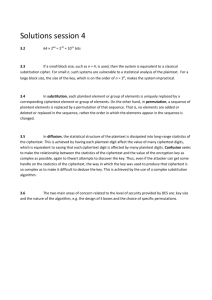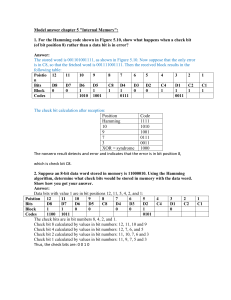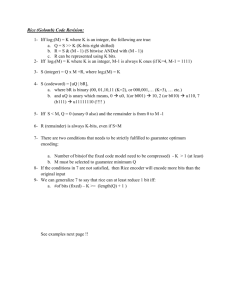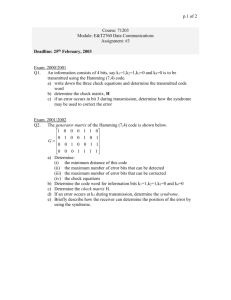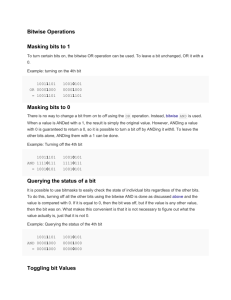DES
advertisement
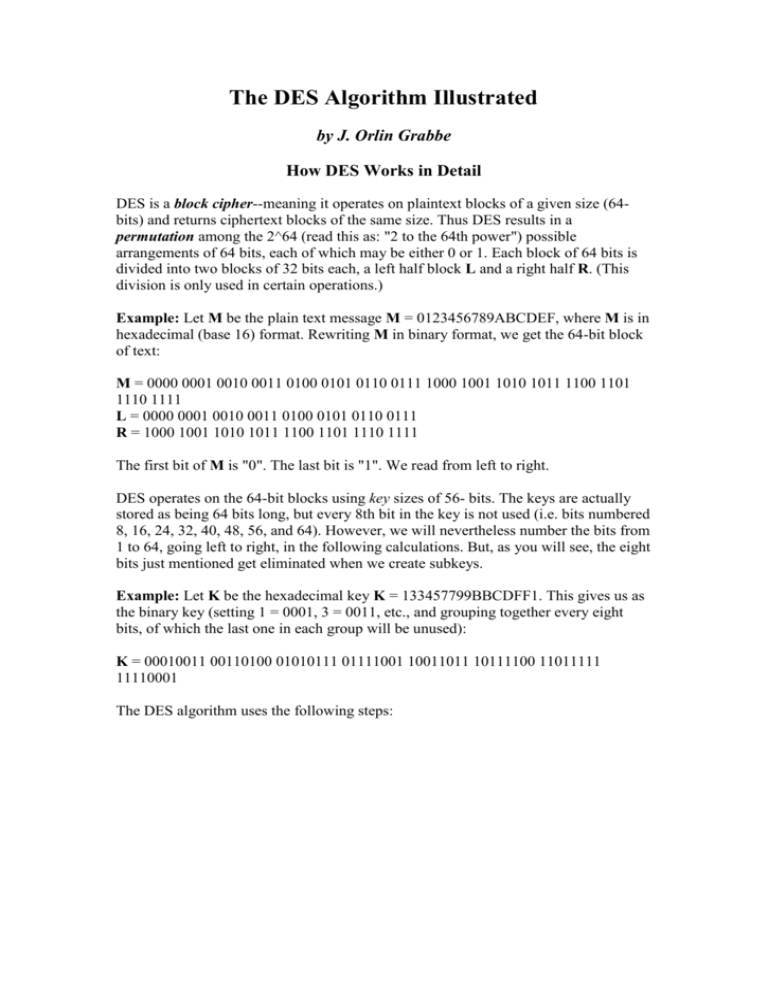
The DES Algorithm Illustrated by J. Orlin Grabbe How DES Works in Detail DES is a block cipher--meaning it operates on plaintext blocks of a given size (64bits) and returns ciphertext blocks of the same size. Thus DES results in a permutation among the 2^64 (read this as: "2 to the 64th power") possible arrangements of 64 bits, each of which may be either 0 or 1. Each block of 64 bits is divided into two blocks of 32 bits each, a left half block L and a right half R. (This division is only used in certain operations.) Example: Let M be the plain text message M = 0123456789ABCDEF, where M is in hexadecimal (base 16) format. Rewriting M in binary format, we get the 64-bit block of text: M = 0000 0001 0010 0011 0100 0101 0110 0111 1000 1001 1010 1011 1100 1101 1110 1111 L = 0000 0001 0010 0011 0100 0101 0110 0111 R = 1000 1001 1010 1011 1100 1101 1110 1111 The first bit of M is "0". The last bit is "1". We read from left to right. DES operates on the 64-bit blocks using key sizes of 56- bits. The keys are actually stored as being 64 bits long, but every 8th bit in the key is not used (i.e. bits numbered 8, 16, 24, 32, 40, 48, 56, and 64). However, we will nevertheless number the bits from 1 to 64, going left to right, in the following calculations. But, as you will see, the eight bits just mentioned get eliminated when we create subkeys. Example: Let K be the hexadecimal key K = 133457799BBCDFF1. This gives us as the binary key (setting 1 = 0001, 3 = 0011, etc., and grouping together every eight bits, of which the last one in each group will be unused): K = 00010011 00110100 01010111 01111001 10011011 10111100 11011111 11110001 The DES algorithm uses the following steps: Step 1: Create 16 subkeys, each of which is 48-bits long. The 64-bit key is permuted according to the following table, PC-1. Since the first entry in the table is "57", this means that the 57th bit of the original key K becomes the first bit of the permuted key K+. The 49th bit of the original key becomes the second bit of the permuted key. The 4th bit of the original key is the last bit of the permuted key. Note only 56 bits of the original key appear in the permuted key. PC-1 57 1 10 19 63 7 14 21 49 58 2 11 55 62 6 13 41 50 59 3 47 54 61 5 33 42 51 60 39 46 53 28 25 34 43 52 31 38 45 20 17 26 35 44 23 30 37 12 9 18 27 36 15 22 29 4 Example: From the original 64-bit key K = 00010011 00110100 01010111 01111001 10011011 10111100 11011111 11110001 we get the 56-bit permutation K+ = 1111000 0110011 0010101 0101111 0101010 1011001 1001111 0001111 Next, split this key into left and right halves, C0 and D0, where each half has 28 bits. Example: From the permuted key K+, we get C0 = 1111000 0110011 0010101 0101111 D0 = 0101010 1011001 1001111 0001111 With C0 and D0 defined, we now create sixteen blocks Cn and Dn, 1<=n<=16. Each pair of blocks Cn and Dn is formed from the previous pair Cn-1 and Dn-1, respectively, for n = 1, 2, ..., 16, using the following schedule of "left shifts" of the previous block. To do a left shift, move each bit one place to the left, except for the first bit, which is cycled to the end of the block. Iteration Number 1 2 3 4 5 6 7 8 Number of Left Shifts 1 1 2 2 2 2 2 2 9 10 11 12 13 14 15 16 1 2 2 2 2 2 2 1 This means, for example, C3 and D3 are obtained from C2 and D2, respectively, by two left shifts, and C16 and D16 are obtained from C15 and D15, respectively, by one left shift. In all cases, by a single left shift is meant a rotation of the bits one place to the left, so that after one left shift the bits in the 28 positions are the bits that were previously in positions 2, 3,..., 28, 1. Example: From original pair C0 and D0 we obtain: C0 = 1111000011001100101010101111 D0 = 0101010101100110011110001111 C1 = 1110000110011001010101011111 D1 = 1010101011001100111100011110 C2 = 1100001100110010101010111111 D2 = 0101010110011001111000111101 C3 = 0000110011001010101011111111 D3 = 0101011001100111100011110101 C4 = 0011001100101010101111111100 D4 = 0101100110011110001111010101 C5 = 1100110010101010111111110000 D5 = 0110011001111000111101010101 C6 = 0011001010101011111111000011 D6 = 1001100111100011110101010101 C7 = 1100101010101111111100001100 D7 = 0110011110001111010101010110 C8 = 0010101010111111110000110011 D8 = 1001111000111101010101011001 C9 = 0101010101111111100001100110 D9 = 0011110001111010101010110011 C10 = 0101010111111110000110011001 D10 = 1111000111101010101011001100 C11 = 0101011111111000011001100101 D11 = 1100011110101010101100110011 C12 = 0101111111100001100110010101 D12 = 0001111010101010110011001111 C13 = 0111111110000110011001010101 D13 = 0111101010101011001100111100 C14 = 1111111000011001100101010101 D14 = 1110101010101100110011110001 C15 = 1111100001100110010101010111 D15 = 1010101010110011001111000111 C16 = 1111000011001100101010101111 D16 = 0101010101100110011110001111 We now form the keys Kn, for 1<=n<=16, by applying the following permutation table to each of the concatenated pairs CnDn. Each pair has 56 bits, but PC-2 only uses 48 of these. PC-2 14 3 23 16 41 30 44 46 17 28 19 7 52 40 49 42 11 15 12 27 31 51 39 50 24 6 4 20 37 45 56 36 1 21 26 13 47 33 34 29 5 10 8 2 55 48 53 32 Therefore, the first bit of Kn is the 14th bit of CnDn, the second bit the 17th, and so on, ending with the 48th bit of Kn being the 32th bit of CnDn. Example: For the first key we have C1D1 = 1110000 1100110 0101010 1011111 1010101 0110011 0011110 0011110 which, after we apply the permutation PC-2, becomes K1 = 000110 110000 001011 101111 111111 000111 000001 110010 For the other keys we have K2 = 011110 011010 111011 011001 110110 111100 100111 100101 K3 = 010101 011111 110010 001010 010000 101100 111110 011001 K4 = 011100 101010 110111 010110 110110 110011 010100 011101 K5 = 011111 001110 110000 000111 111010 110101 001110 101000 K6 = 011000 111010 010100 111110 010100 000111 101100 101111 K7 = 111011 001000 010010 110111 111101 100001 100010 111100 K8 = 111101 111000 101000 111010 110000 010011 101111 111011 K9 = 111000 001101 101111 101011 111011 011110 011110 000001 K10 = 101100 011111 001101 000111 101110 100100 011001 001111 K11 = 001000 010101 111111 010011 110111 101101 001110 000110 K12 = 011101 010111 000111 110101 100101 000110 011111 101001 K13 = 100101 111100 010111 010001 111110 101011 101001 000001 K14 = 010111 110100 001110 110111 111100 101110 011100 111010 K15 = 101111 111001 000110 001101 001111 010011 111100 001010 K16 = 110010 110011 110110 001011 000011 100001 011111 110101 So much for the subkeys. Now we look at the message itself. Step 2: Encode each 64-bit block of data. There is an initial permutation IP of the 64 bits of the message data M. This rearranges the bits according to the following table, where the entries in the table show the new arrangement of the bits from their initial order. The 58th bit of M becomes the first bit of IP. The 50th bit of M becomes the second bit of IP. The 7th bit of M is the last bit of IP. IP 58 60 62 64 57 59 61 63 50 52 54 56 49 51 53 55 42 44 46 48 41 43 45 47 34 36 38 40 33 35 37 39 26 28 30 32 25 27 29 31 18 20 22 24 17 19 21 23 10 12 14 16 9 11 13 15 2 4 6 8 1 3 5 7 Example: Applying the initial permutation to the block of text M, given previously, we get M = 0000 0001 0010 0011 0100 0101 0110 0111 1000 1001 1010 1011 1100 1101 1110 1111 IP = 1100 1100 0000 0000 1100 1100 1111 1111 1111 0000 1010 1010 1111 0000 1010 1010 Here the 58th bit of M is "1", which becomes the first bit of IP. The 50th bit of M is "1", which becomes the second bit of IP. The 7th bit of M is "0", which becomes the last bit of IP. Next divide the permuted block IP into a left half L0 of 32 bits, and a right half R0 of 32 bits. Example: From IP, we get L0 and R0 L0 = 1100 1100 0000 0000 1100 1100 1111 1111 R0 = 1111 0000 1010 1010 1111 0000 1010 1010 We now proceed through 16 iterations, for 1<=n<=16, using a function f which operates on two blocks--a data block of 32 bits and a key Kn of 48 bits--to produce a block of 32 bits. Let + denote XOR addition, (bit-by-bit addition modulo 2). Then for n going from 1 to 16 we calculate Ln = Rn-1 Rn = Ln-1 + f(Rn-1,Kn) This results in a final block, for n = 16, of L16R16. That is, in each iteration, we take the right 32 bits of the previous result and make them the left 32 bits of the current step. For the right 32 bits in the current step, we XOR the left 32 bits of the previous step with the calculation f . Example: For n = 1, we have K1 = 000110 110000 001011 101111 111111 000111 000001 110010 L1 = R0 = 1111 0000 1010 1010 1111 0000 1010 1010 R1 = L0 + f(R0,K1) It remains to explain how the function f works. To calculate f, we first expand each block Rn-1 from 32 bits to 48 bits. This is done by using a selection table that repeats some of the bits in Rn-1 . We'll call the use of this selection table the function E. Thus E(Rn-1) has a 32 bit input block, and a 48 bit output block. Let E be such that the 48 bits of its output, written as 8 blocks of 6 bits each, are obtained by selecting the bits in its inputs in order according to the following table: E BIT-SELECTION TABLE 32 4 8 12 16 20 24 28 1 5 9 13 17 21 25 29 2 6 10 14 18 22 26 30 3 7 11 15 19 23 27 31 4 8 12 16 20 24 28 32 5 9 13 17 21 25 29 1 Thus the first three bits of E(Rn-1) are the bits in positions 32, 1 and 2 of Rn-1 while the last 2 bits of E(Rn-1) are the bits in positions 32 and 1. Example: We calculate E(R0) from R0 as follows: R0 = 1111 0000 1010 1010 1111 0000 1010 1010 E(R0) = 011110 100001 010101 010101 011110 100001 010101 010101 (Note that each block of 4 original bits has been expanded to a block of 6 output bits.) Next in the f calculation, we XOR the output E(Rn-1) with the key Kn: Kn + E(Rn-1). Example: For K1 , E(R0), we have K1 = 000110 110000 001011 101111 111111 000111 000001 110010 E(R0) = 011110 100001 010101 010101 011110 100001 010101 010101 K1+E(R0) = 011000 010001 011110 111010 100001 100110 010100 100111. We have not yet finished calculating the function f . To this point we have expanded Rn-1 from 32 bits to 48 bits, using the selection table, and XORed the result with the key Kn . We now have 48 bits, or eight groups of six bits. We now do something strange with each group of six bits: we use them as addresses in tables called "S boxes". Each group of six bits will give us an address in a different S box. Located at that address will be a 4 bit number. This 4 bit number will replace the original 6 bits. The net result is that the eight groups of 6 bits are transformed into eight groups of 4 bits (the 4-bit outputs from the S boxes) for 32 bits total. Write the previous result, which is 48 bits, in the form: Kn + E(Rn-1) =B1B2B3B4B5B6B7B8, where each Bi is a group of six bits. We now calculate S1(B1)S2(B2)S3(B3)S4(B4)S5(B5)S6(B6)S7(B7)S8(B8) where Si(Bi) referres to the output of the i-th S box. To repeat, each of the functions S1, S2,..., S8, takes a 6-bit block as input and yields a 4-bit block as output. The table to determine S1 is shown and explained below: S1 Column Number Row No. 0 1 2 3 0 1 2 3 14 4 0 15 4 1 15 12 13 7 14 8 1 4 8 2 4 5 2 15 14 2 13 6 4 9 6 7 11 8 13 1 2 11 1 7 8 9 10 11 12 13 14 15 3 10 10 6 15 12 5 11 6 12 12 11 9 7 3 14 5 9 9 5 3 10 10 0 0 7 3 8 5 0 6 13 If S1 is the function defined in this table and B is a block of 6 bits, then S1(B) is determined as follows: The first and last bits of B represent in base 2 a number in the decimal range 0 to 3 (or binary 00 to 11). Let that number be i. The middle 4 bits of B represent in base 2 a number in the decimal range 0 to 15 (binary 0000 to 1111). Let that number be j. Look up in the table the number in the i-th row and j-th column. It is a number in the range 0 to 15 and is uniquely represented by a 4 bit block. That block is the output S1(B) of S1 for the input B. For example, for input block B = 011011 the first bit is "0" and the last bit "1" giving 01 as the row. This is row 1. The middle four bits are "1101". This is the binary equivalent of decimal 13, so the column is column number 13. In row 1, column 13 appears 5. This determines the output; 5 is binary 0101, so that the output is 0101. Hence S1(011011) = 0101. The tables defining the functions S1,...,S8 are the following: S1 14 4 0 15 4 1 15 12 13 7 14 8 1 4 8 2 2 15 14 2 13 6 4 9 11 8 13 1 2 11 1 7 3 10 10 6 15 12 5 11 6 12 12 11 9 7 3 14 5 9 9 5 3 10 10 0 0 7 3 8 5 0 6 13 9 12 5 11 7 0 8 6 2 13 1 10 12 6 7 12 12 6 9 0 0 9 3 5 5 10 11 5 2 15 14 9 1 13 2 8 11 1 4 15 12 7 5 14 2 12 14 3 11 4 12 11 5 10 11 5 2 8 15 1 14 7 2 12 2 7 1 4 8 5 2 12 3 14 5 11 11 12 1 10 5 2 12 7 4 15 14 9 8 4 2 14 8 5 5 0 15 9 6 15 3 15 15 10 12 5 0 9 13 3 6 10 0 9 3 4 14 9 8 6 0 14 5 3 0 13 6 1 7 0 11 14 3 4 13 14 4 10 1 7 14 7 0 11 1 13 6 0 5 11 3 8 11 6 8 13 3 12 14 3 10 15 9 5 9 7 5 12 6 8 0 15 5 10 2 15 0 5 14 2 6 1 8 6 9 2 3 12 10 9 12 5 0 6 15 12 3 14 6 11 10 13 9 0 5 0 0 14 15 3 3 5 12 7 9 2 5 8 6 11 S2 15 1 3 13 0 14 13 8 8 14 4 7 7 11 10 1 6 11 15 2 10 4 3 15 3 4 8 14 13 1 4 2 S3 10 0 13 7 13 6 1 10 9 14 0 9 4 9 13 0 6 3 3 4 8 15 6 9 15 5 6 10 3 0 8 7 S4 7 13 13 8 10 6 3 15 14 11 9 0 3 5 0 6 0 6 6 15 12 11 10 1 9 10 0 3 7 13 13 8 1 4 15 9 S5 2 12 14 11 4 2 11 8 4 1 2 12 1 11 12 7 7 10 4 7 10 13 1 14 11 6 13 1 7 8 2 13 S6 12 1 10 15 9 14 4 3 10 15 4 2 15 5 2 12 9 2 7 12 2 8 9 5 6 8 9 5 12 3 15 10 S7 4 11 13 0 1 4 6 11 2 14 11 7 11 13 13 8 15 4 12 1 0 9 3 4 8 13 1 10 7 14 10 7 S8 13 2 1 15 7 11 2 1 8 13 4 14 4 8 1 7 6 15 10 3 9 12 4 10 11 1 7 4 14 2 8 13 Example: For the first round, we obtain as the output of the eight S boxes: K1 + E(R0) = 011000 010001 011110 111010 100001 100110 010100 100111. S1(B1)S2(B2)S3(B3)S4(B4)S5(B5)S6(B6)S7(B7)S8(B8) = 0101 1100 1000 0010 1011 0101 1001 0111 The final stage in the calculation of f is to do a permutation P of the S-box output to obtain the final value of f: f = P(S1(B1)S2(B2)...S8(B8)) The permutation P is defined in the following table. P yields a 32-bit output from a 32-bit input by permuting the bits of the input block. P 16 29 1 5 2 32 19 22 7 12 15 18 8 27 13 11 20 28 23 31 24 3 30 4 21 17 26 10 14 9 6 25 Example: From the output of the eight S boxes: S1(B1)S2(B2)S3(B3)S4(B4)S5(B5)S6(B6)S7(B7)S8(B8) = 0101 1100 1000 0010 1011 0101 1001 0111 we get f = 0010 0011 0100 1010 1010 1001 1011 1011 R1 = L0 + f(R0 , K1 ) = 1100 1100 0000 0000 1100 1100 1111 1111 + 0010 0011 0100 1010 1010 1001 1011 1011 = 1110 1111 0100 1010 0110 0101 0100 0100 In the next round, we will have L2 = R1, which is the block we just calculated, and then we must calculate R2 =L1 + f(R1, K2), and so on for 16 rounds. At the end of the sixteenth round we have the blocks L16 and R16. We then reverse the order of the two blocks into the 64-bit block R16L16 and apply a final permutation IP-1 as defined by the following table: IP-1 40 39 38 8 7 6 48 47 46 16 15 14 56 55 54 24 23 22 64 63 62 32 31 30 37 36 35 34 33 5 4 3 2 1 45 44 43 42 41 13 12 11 10 9 53 52 51 50 49 21 20 19 18 17 61 60 59 58 57 29 28 27 26 25 That is, the output of the algorithm has bit 40 of the preoutput block as its first bit, bit 8 as its second bit, and so on, until bit 25 of the preoutput block is the last bit of the output. Example: If we process all 16 blocks using the method defined previously, we get, on the 16th round, L16 = 0100 0011 0100 0010 0011 0010 0011 0100 R16 = 0000 1010 0100 1100 1101 1001 1001 0101 We reverse the order of these two blocks and apply the final permutation to R16L16 = 00001010 01001100 11011001 10010101 01000011 01000010 00110010 00110100 IP-1 = 10000101 11101000 00010011 01010100 00001111 00001010 10110100 00000101 which in hexadecimal format is 85E813540F0AB405. This is the encrypted form of M = 0123456789ABCDEF: namely, C = 85E813540F0AB405. Decryption is simply the inverse of encryption, follwing the same steps as above, but reversing the order in which the subkeys are applied. DES Modes of Operation The DES algorithm turns a 64-bit message block M into a 64-bit cipher block C. If each 64-bit block is encrypted individually, then the mode of encryption is called Electronic Code Book (ECB) mode. There are two other modes of DES encryption, namely Chain Block Coding (CBC) and Cipher Feedback (CFB), which make each cipher block dependent on all the previous messages blocks through an initial XOR operation. Cracking DES Before DES was adopted as a national standard, during the period NBS was soliciting comments on the proposed algorithm, the creators of public key cryptography, Martin Hellman and Whitfield Diffie, registered some objections to the use of DES as an encryption algorithm. Hellman wrote: "Whit Diffie and I have become concerned that the proposed data encryption standard, while probably secure against commercial assault, may be extremely vulnerable to attack by an intelligence organization" (letter to NBS, October 22, 1975). Diffie and Hellman then outlined a "brute force" attack on DES. (By "brute force" is meant that you try as many of the 2^56 possible keys as you have to before decrypting the ciphertext into a sensible plaintext message.) They proposed a special purpose "parallel computer using one million chips to try one million keys each" per second, and estimated the cost of such a machine at $20 million. Fast forward to 1998. Under the direction of John Gilmore of the EFF, a team spent $220,000 and built a machine that can go through the entire 56-bit DES key space in an average of 4.5 days. On July 17, 1998, they announced they had cracked a 56-bit key in 56 hours. The computer, called Deep Crack, uses 27 boards each containing 64 chips, and is capable of testing 90 billion keys a second. Despite this, as recently as June 8, 1998, Robert Litt, principal associate deputy attorney general at the Department of Justice, denied it was possible for the FBI to crack DES: "Let me put the technical problem in context: It took 14,000 Pentium computers working for four months to decrypt a single message . . . . We are not just talking FBI and NSA [needing massive computing power], we are talking about every police department." Responded cryptograpy expert Bruce Schneier: " . . . the FBI is either incompetent or lying, or both." Schneier went on to say: "The only solution here is to pick an algorithm with a longer key; there isn't enough silicon in the galaxy or enough time before the sun burns out to brute- force triple-DES" (Crypto-Gram, Counterpane Systems, August 15, 1998). Triple-DES Triple-DES is just DES with two 56-bit keys applied. Given a plaintext message, the first key is used to DES- encrypt the message. The second key is used to DES-decrypt the encrypted message. (Since the second key is not the right key, this decryption just scrambles the data further.) The twice-scrambled message is then encrypted again with the first key to yield the final ciphertext. This three-step procedure is called triple-DES. Triple-DES is just DES done three times with two keys used in a particular order. (Triple-DES can also be done with three separate keys instead of only two. In either case the resultant key space is about 2^112.) General References "Cryptographic Algorithms for Protection of Computer Data During Transmission and Dormant Storage," Federal Register 38, No. 93 (May 15, 1973). Data Encryption Standard, Federal Information Processing Standard (FIPS) Publication 46, National Bureau of Standards, U.S. Department of Commerce, Washington D.C. (January 1977). Carl H. Meyer and Stephen M. Matyas, Cryptography: A New Dimension in Computer Data Security, John Wiley & Sons, New York, 1982. Dorthy Elizabeth Robling Denning, Cryptography and Data Security, AddisonWesley Publishing Company, Reading, Massachusetts, 1982. D.W. Davies and W.L. Price, Security for Computer Networks: An Introduction to Data Security in Teleprocessing and Electronics Funds Transfer, Second Edition, John Wiley & Sons, New York, 1984, 1989. Miles E. Smid and Dennis K. Branstad, "The Data Encryption Standard: Past and Future," in Gustavus J. Simmons, ed., Contemporary Cryptography: The Science of Information Integrity, IEEE Press, 1992. Douglas R. Stinson, Cryptography: Theory and Practice, CRC Press, Boca Raton, 1995. Bruce Schneier, Applied Cryptography, Second Edition, John Wiley & Sons, New York, 1996. Alfred J. Menezes, Paul C. van Oorschot, and Scott A. Vanstone, Handbook of Applied Cryptography, CRC Press, Boca Raton, 1997. -30This article appeared in Laissez Faire City Times, Vol 2, No. 28. Homepage: http://orlingrabbe.com/ Laissez Faire City Times: http://zolatimes.com/

